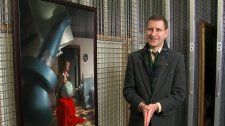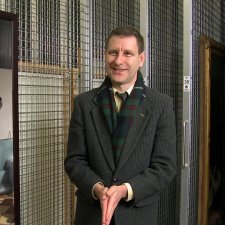Professor Penny Sackett and artist Andrew Mezei describe the process behind making the portrait.
This video was produced with funds donated by Tim Fairfax AC.
Professor Penny Sackett and artist Andrew Mezei describe the process behind making the portrait.
This video was produced with funds donated by Tim Fairfax AC.
Andrew: Actually, I was in the studio painting a landscape, and I was listening to Phillip Adams, and he was interviewing the then new chief scientist for Australia, Professor Penny Sackett. So I was listening to this conversation, and it just struck me what an engaged and articulate voice she had on the radio, and I thought I was really engaged with what she was saying. It was very much against the backdrop of fairly strong political and personal attacks about the issue of climate change at the time, it was a very heated kind of discussion, and here was a voice that was entirely reasoned, and yet warm and engaging. And I was really inspired to paint her at that moment.
Penny: Well, I will say that the idea of having my portrait painted was a bit daunting, and I’ve been asked twice before and declined. But this was a little bit different, I think, for a couple of reasons. First of all, I was in the position of Chief Scientist, and in that role it’s important to try and bring science to everyone. And the people in my office said, “You know, Penny, this is an opportunity to do something completely different, that a Chief Scientist wouldn’t normally do,” and that’s to reach out and really in a very different way, talk about how science and art are part of the same human experience.
As a physicist and astronomer, I know a little bit about the optics of a camera, but I don’t necessarily know about the optics of an artist mind, and, you know, what would the artist see? I suppose it did take a bit of bravery on my part, but what overcame that was a kind of trust that I developed in Andrew, because he did explain what he was trying to portray in the painting, and it was a story. I think ... it’s a deep story, there are layers, the more you look at the portrait, the more you see; and I was a part of that story, I was really there to help him tell it. And so my image was important to him to tell the story that he wanted to tell.
Andrew: I didn’t want it just to be a portrait where you’ve got a sitter, and that’s it. It was very much a figure in an environment. Because I’m a landscape painter, it came about as a kind of an interior landscaping, in a sense, in that in the same way that the Dutch painters create a space that has so much interior depth that you can project yourself almost as far as you want to.
Penny: When the painting was unveiled, my memory was of not saying anything at all. I couldn’t ... my memory is just being drawn into the painting, and just looking at it. It was somehow bigger than I thought, I mean you could see the size of it, of course, under the velvet; but it looked bigger, somehow, after it was unveiled. And the first thing I remember was being struck by the quality of light, which again is so important in the early Dutch works. I think that was the first thing, that it looked luminous, as though it was almost, you know, giving off a light of its own. And my memory was of being speechless, which is not necessarily a normal state for me. But I’m told that I actually did say something in response.
Andrew: Yes, the way I recall it was that Penny looked at it and took it in, and then looked really closely and said, “Oh my, that’s my finger.”
Penny: After Andrew reminded me, I did remember my remark about the finger, and it’s difficult to explain what I mean by likeness, it isn’t so much that it looks like my finger and, I don’t know, skin tone, or anything like that. It’s the posture of a finger, if there could be such a thing, and I recognised it as that’s the way I hold my hand. And I suppose I’m not used to looking at my face very much, I’m more used to looking at my hands; I do my work with my hands. So, in some sense, they’re more a part of me that I identify with than my face, and to realise that that had been captured, that posture had been captured in the painting was remarkable, because it was personal. I didn’t think anybody else would notice how I held my hands, you know, that seems a very personal thing. And it was, it was personal.



Professor Penny Sackett, Australian National University and former Chief Scientist for Australia (2008-2011) talks about her life in science.



Artist Andrew Mezei talks about his art practice and the process behind his portrait of Professor Penny Sackett.



Visit us, learn with us, support us or work with us! Here’s a range of information about planning your visit, our history and more!